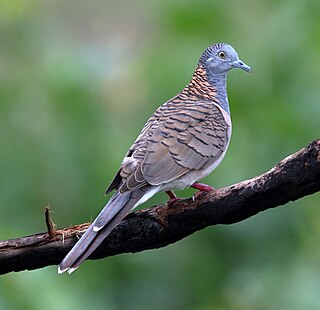
The bar-shouldered dove is native to Australia and southern New Guinea. It is protected under the National Parks and Wildlife Act 1974. It is a medium-sized pigeon varying in size from 26 to 30 centimetres. Its voice is a distinctive and melodious "cook-a-wook" or "coolicoo".
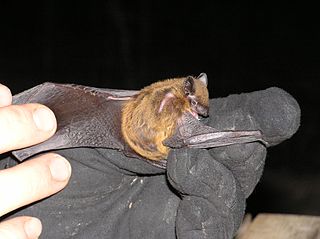
Nycticeius is a small genus of bats in the vesper bat family, Vespertilionidae. It contains three species, the evening bat, the Cuban evening bat and Nycticeius aenobarbus. Some authorities include several other Old World species in Nycticeius, but recent genetic work shows that is a completely New World genus. Nycticeius is of Greek and Latin origin, meaning "belonging to the night".

The evening bat is a species of bat in the vesper bat family that is native to North America.
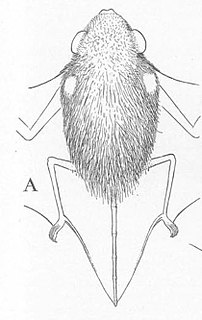
Allen's spotted bat is a species of vesper bat in the family Vespertilionidae found in the following countries: the Central African Republic, the Democratic Republic of the Congo, Kenya, and Uganda. It is found in subtropical or tropical moist lowland forests.

The yellow-shouldered grosbeak is a songbird species in the tanager family (Thraupidae), or possibly in the Cardinalidae. It is the only member of its genus Parkerthraustes.

Humerana humeralis is a species of frog in the family Ranidae. It is found in Bangladesh, India, Myanmar, Nepal, and possibly Bhutan. Its natural habitats are subtropical or tropical moist lowland forests and rivers. It is threatened by habitat loss.

The tawny-shouldered blackbird is a species of bird in the family Icteridae. It is found in Cuba and Haiti. It is a vagrant in the United States.

The black-chested sparrow is a species of bird in the Passerellidae family that is endemic to Mexico.
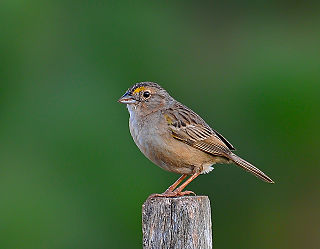
The grassland sparrow is a species of bird in the family Passerellidae. It is found in Argentina, Bolivia, Brazil, Colombia, French Guiana, Guyana, Paraguay, Peru, Suriname, Uruguay, and Venezuela. Its natural habitats are dry savannah, subtropical or tropical seasonally wet or flooded lowland grassland, and pastureland.

The white-throated robin-chat or white-throated robin is a species of bird in the family Muscicapidae. It is endemic to Botswana, Mozambique, South Africa, Swaziland, and Zimbabwe. Its natural habitats are dry savannah and subtropical or tropical dry shrubland.

The chestnut-shouldered antwren is an insectorivous bird in the antbird family Thamnophilidae. It is found in far northwestern Bolivia, Peru, Ecuador and western Brazil. Its natural habitat is subtropical or tropical moist lowland forests.
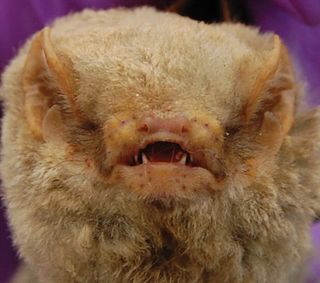
Glauconycteris is a genus of vespertilionid bats in Africa.
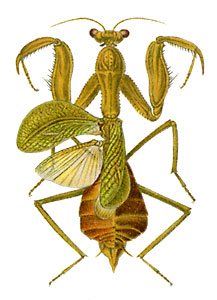
Cilnia humeralis, common name wide-armed mantis, is an aggressive and very cannibalistic species of praying mantis from Africa.
The Cuban evening bat is a species of bat in the vesper bat family, Vespertilionidae, that is endemic to western Cuba. It is a small bat, even smaller than cogener Nycticeius humeralis. It is insectivorous, but otherwise little is known about its behavior and diet.

The northern fiscal is a member of the shrike family found through most of Sub-Saharan Africa. It used to be grouped with the southern fiscal. Together they were called the common fiscal.
Hemilophini is a tribe of longhorn beetles of the Lamiinae subfamily.
Megalofrea humeralis is a species of beetle in the family Cerambycidae. It was described by Vollehoven in 1869. It is known from Madagascar.
Phytoecia humeralis is a species of beetle in the family Cerambycidae. It was described by Waltl in 1838, originally under the genus Saperda. It is known from Palestine, Greece, Georgia, Iran, Azerbaijan, Syria, Cyprus, and Turkey. It feeds on Silybum marianum.

Arge humeralis, the poison ivy sawfly, is a species of argid sawfly in the family Argidae.

Anisotoma humeralis is a species of round fungus beetle in the family Leiodidae. It is found in Europe & Northern Asia and North America.
















